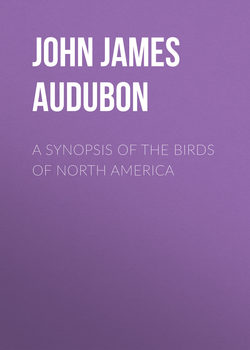Читать книгу A Synopsis of the Birds of North America - John James Audubon - Страница 80
FAMILY XII. TURDINÆ. THRUSHES
ОглавлениеBill short, or of moderate length, rather strong, straight, compressed toward the end; upper mandible with its dorsal outline a little convex and declinate, the tip small, rather acute, the notches small; lower mandible with the angle rather short, of moderate width, the dorsal line straight, the sides convex, the tip acute. Head oblong, compressed, of moderate size; neck rather short; body moderate. Eyes of moderate size. External aperture of ear large and roundish. Feet of moderate strength; tarsus compressed, with seven anterior scutella; toes rather strong, compressed; first, second, and fourth, nearly equal, third much longer, and adherent to the fourth at the base; claws rather long, arched, compressed, laterally grooved, acute. Plumage rather blended. Bristles small. Wings of moderate length, broad, rounded; the first quill very small, third and fourth longest. Tail of twelve feathers, varying in length. Tongue sagittate, and papillate at the base, slender, tapering, its tip slit. Œsophagus rather narrow, without crop; proventriculus oblong; stomach a gizzard of moderate strength, its lateral and lower muscles distinct; the epithelium dense and rugous; intestine of moderate length; cœca very small, cylindrical. Trachea simple, with four pairs of inferior laryngeal muscles.
GENUS I. CINCLUS, Bechst. DIPPER
Bill rather short, slender, slightly ascending, much compressed toward the end; upper mandible with its dorsal line straight until toward the end, the ridge rounded, the sides convex, the edges somewhat inflected, with an obscure notch close to the narrow deflected tip; lower mandible slightly bent upwards, the angle medial and very narrow, the dorsal line ascending and slightly convex, the tip narrow and rather acute. Nostrils linear, direct, exposed. General form short, full, and compact. Head oblong, compressed. Legs strong; tarsus of moderate length, compressed, covered anteriorly with a long undivided plate and four inferior scutella; toes rather large and strong; claws arched, much compressed, laterally grooved, that of the hind toe considerably larger. Plumage ordinary, rather blended. Bristles obsolete. Wings rather short, convex, rounded. Tail short, even.
137. 1. Cinclus Americanus, Swains. American Dipper
Plate CCCLXX. Adult. Plate CCCCXXXV. Young.
Head and neck chocolate-brown, upper parts very deep bluish-grey, lower somewhat lighter, and tinged anteriorly with brown. Young with the upper parts deep bluish-grey, the head and hind neck slightly tinged with brown; lower parts lighter, the feathers margined with whitish, the throat with a slight tinge of brown.
Male, 71/2, 101/2.
Rocky Mountains. Oregon Territory. North California. Not abundant.
Cinclus Pallasii, Bonap. Amer. Orn. v. ii. p. 173.
Cinclus Americanus, American Dipper, Swains. & Rich. F. Bor. Amer. v. ii. p. 173.
Black Water-Ouzel or Dipper, Nutt. Man. v. ii. p. 358.
American Dipper, Cinclus Americanus, Aud. Orn. Biog. v. iv. p. 493; v. v. p. 303.
GENUS II. ORPHEUS, Swains. MOCKING-BIRD
Bill of moderate length or longish, rather slender, straight or slightly arched, broader than high at the base, compressed toward the end, acute; upper mandible with the ridge rather narrow, the sides convex toward the end, the notches very slight, the tip narrow; lower mandible with the angle of moderate length, the dorsal line straight or slightly decurved toward the end, the sides nearly erect, the tip narrow. Nostrils oblong, partially concealed by the feathers. Head of ordinary size, ovato-oblong; neck of moderate length; body rather slender. Feet of ordinary length, slender; tarsus scarcely so long as the middle toe and claw; hind toe of moderate length, stout, lateral toes equal; claws moderate, arched, compressed, acute. Plumage soft and blended. Bristles rather long. Wings of ordinary length, broad, rounded, the first quill very small, the fourth and fifth longest. Tail very long, straight, much rounded, or graduated.
138. 1. Orpheus polyglottus, Linn. Grey Mocking-Bird
Plate XXI. Male and Female.
Upper parts light grey tinged with yellowish-brown; feathers of the wings and tail greyish-black; primary coverts white, as are the primary quills in their proximal part; secondary coverts and first row of small coverts tipped with white; outer tail-feather white, as are the greater part of the next, and a portion of the third toward the end; lower parts greyish-white, on the breast tinged with brown, on the sides and under the tail with yellow. Female smaller, with the tints duller, and the white markings on the wings less extended.
Male, 91/2, 131/2. Female, 9, 121/2.
From Texas to Massachusetts. In the interior up the Mississippi and Ohio, to Henderson in Kentucky. Abundant and resident in the southern parts.
Mocking Bird, Turdus polyglottus, Wils. Amer. Orn. v. ii. p. 14.
Turdus polyglottus, Bonap. Syn. p. 74.
Mocking Bird, Turdus polyglottus, Nutt. Man. v. i. p. 320.
Mocking Bird, Turdus polyglottus, Aud. Orn. Biog. v. i. p. 108; v. v. p. 438.
139. 2. Orpheus montanus, Townsend. Mountain Mocking-Bird
Plate CCCLXIX. Fig. 1. Male.
Upper parts greyish-brown; feathers of the wings and tail greyish-black; tips of secondary coverts, edges of primary quills, and a large spot at the end of the three lateral tail-feathers, white; lower parts whitish, marked with triangular dusky spots, of which there is a distinct line from the base of the bill; throat, middle of the breast, abdomen, and lower tail-coverts, unspotted.
Male, 8; wing, 39/12.
Rocky Mountains. Common. Migratory.
Orpheus montanus, Mountain Mocking-Bird, Towns. Journ. Acad. Nat. Sc. Philadelphia, v. vii. p. 192.
Mountain Mocking Bird, Turdus montanus, Aud. Orn. Biog. v. iv. p. 487.
140. 3. Orpheus Carolinensis, Linn. Black-capped Mocking-Bird. – Cat Bird
Plate CXXVIII. Male and Female.
Blackish-grey, lighter beneath; upper part of head black; lower tail-coverts deep red. Female with the tints duller. Lateral tail-feathers more or less banded with lighter, sometimes whitish tints.
